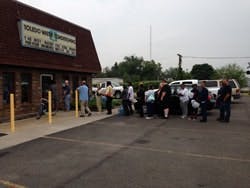About the author: Sara Elliott is assistant editor for WQP. Elliott can be reached at [email protected] or 847.954.7965.
Leonard Keener started Toledo Water Conditioning in 1947. After he returned from serving his country in World War II, he decided to open a business in the water treatment industry so he could provide customers with products that were truly beneficial while also running a company of his own.
Today, his son, John Keener, who grew up in the industry, runs the business. Keener started working for his father full time in 1980 after working as a part-time employee throughout high school and college.
“I remember as a child going to Water Conditioning Assn. Intl. conventions, the predecessor to the WQA Aquatech,” he said. “Reverse osmosis [RO] systems and ultraviolet sterilizers were just becoming commercially viable and were but a shadow of the high-quality products that they are now.”
Since he entered the industry as a second-generation water treatment dealer, Keener says there have been several challenges he has faced, from environmental issues to the rise of the Internet.
“A genuine problem we’ve seen in the [past] 10 years is the proliferation of new water treatment equipment being sold over the Internet,” he said. He has seen people who purchased poorly designed and improperly assembled equipment online, as well as “dealers” making claims on the Web about the capabilities of some of the water treatment equipment being sold. In one case, he saw an RO unit sold directly from an Internet supplier that had greasy handprints on the filters.
It was because of what Keener had seen on the Internet that he started a company policy prohibiting Toledo Water Conditioning from attempting to repair or service units purchased on the Web. “We feel like the likelihood of providing a quality finished product to the consumer would be very small,” Keener said. He explained that because it can be difficult to correctly repair equipment that has internal contamination, incorrect seals or improper control assemblies, he does not want to further take advantage of a consumer who already may have experienced abuse at the hands of
Internet dealers.
Environmental Crisis
When it comes to environmental dangers, Keener has experienced his fair share, especially last year, when the Toledo water crisis struck on Aug. 2, 2014, and the city’s water was considered “unfit to use” due to contamination.
“This was far stronger than a do-not-drink or boil-water order,” Keener said. “The water was contaminated with a toxin called microcystin. This toxin is released by cyanobacteria, [which was] growing in abundance in Lake Erie—the source for Toledo’s drinking water.”
This cyanobacteria, also known as blue-green algae, was growing due to high volumes of nitrogen and phosphorus levels in the lake caused by runoff from surrounding farms and leaky septic tanks.
There are more than 11 million people in the metropolitan area surrounding Toledo. When the water was deemed unusable, Keener’s business was flooded with customers in search of bottled water and for requests for water
treatment services.
Keener and his team appeared on television and radio news stations, discussing RO, filtration and bottled water for three days, until the city of Toledo was able to reduce the contaminants to below the acceptable level of 1 ppb.
“In addition to selling bottled water, we have filters, [RO] and a purified water filling station in our office,” Keener said. “During this time of crisis, we rationed how much any one customer could receive to a maximum of 4 gal per person.”
Toledo Water Conditioning gave away thousands of gallons of purified water and was able to help the community, as well as create goodwill and recognition for the business.
Growing the Business
To help his business stay successful, Keener said that he always keeps one of his father’s favorite sayings in the back of his mind when planning for the future: “Don’t put the cart before the horse.”
Currently, Keener has six full-time and one part-time employee, as well as several seasonal employees. He said that he plans to hire more staff in the near future as the business grows.
“I can say quite literally that every day I am happy to go to work and that I still truly enjoy the water treatment industry,” he said. “My wife Mary has now joined the business full time and it’s a blessing to have her with me, as she brings a great skill set in management and accounting.”
Keener has high hopes for the future of dealers in the water industry. He credited the Water Quality Assn.’s certified specialist program with helping people understand that they are working with professional experts they can trust with their family’s drinking and household water.
“I still believe that professional expertise and business ethics can drive the success of a water treatment business,” he said.
Download: Here
